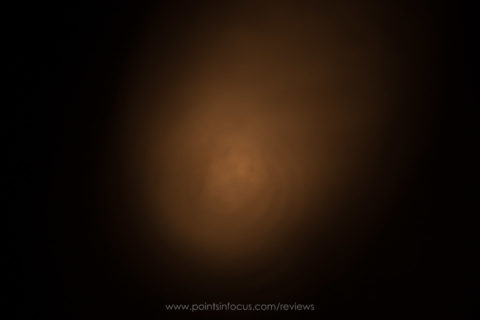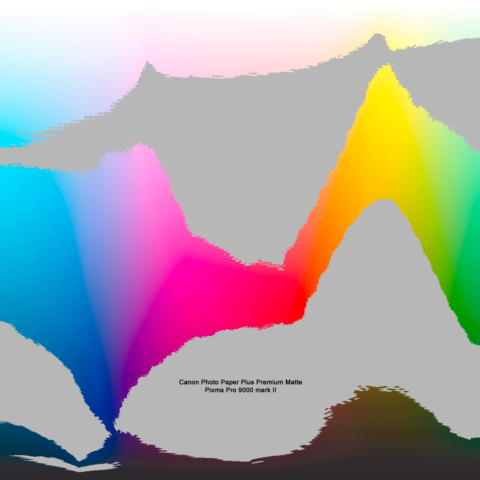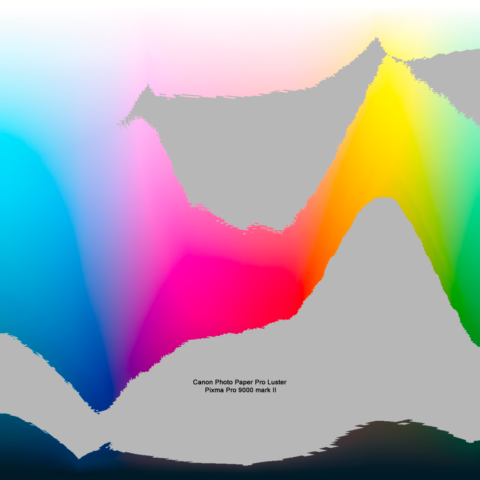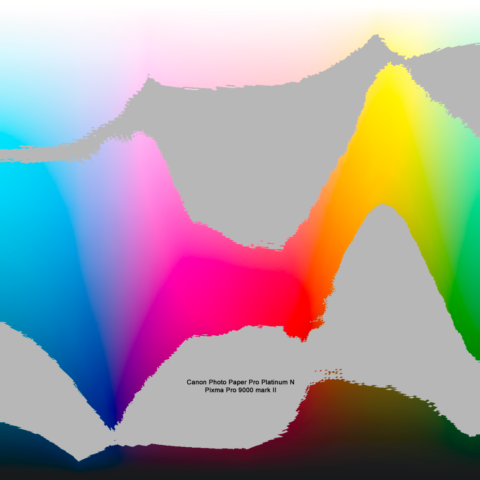Canon Photo Paper Pro Premium Matte Review
For the longest time my goto paper for my Canon printer has been Canon’s Pro Platinum photo paper. However, while it’s high gloss finish is tops for reproducing color and fine detail, there’s something about a big glossy print that’s never really been the ideal for me. I’ve been playing with papers off and on for several years now trying to find ones that I like, and I’ve found many, and ones that also fit in what I considered a good value for the level of printing I’m doing.
After having gone though all of Moab’s papers a number of year ago, and finding some I like but didn’t want to spend the money on, I put off the paper question for a while. Earlier this year, I was given some Canon Photo Paper Plus Semi-Gloss to play with and that rekindled my interest in looking at papers—well that and coming back from a trip to Alaska and having a lot of pictures I wanted to print didn’t hurt either.
I’ve published my thoughts on the Canon’s Photo Paper Pro Luster already, and this will be my look at Canon’s Pro Premium Matte photo paper.
Sorting out Canon Papers
I mentioned the trouble I’ve had with trying to sort out Canon’s papers in my review of their Pro Luster paper. Suffice to say, the Pro Premium Matte paper makes this even more confusing to me.
When I was writing that review, I had expected, perhaps somewhat naively, that the Pro Premium Matte paper would be essentially in the same class as the other two Pro papers (Luster and Platinum). This may very well be true from a branding and pricing perspective, but from a printing perspective, the Pro Premium Matte is treated as a fine art paper—namely because it requires using the 35 mm leading and trailing margins.
In truth, I shouldn’t have been surprised by this detail. Not only is it called out in the fine print on the printer specs that borderless printing isn’t supported with this paper, but also the fact that it’s an uncoated paper which changes the behavior of the ink loaded paper, including potentially contacting the print heads.
In doing some digging, I find that Canon UK’s site probably classifies their papers in the most straight forward way I can think of.
| Photos at Home | Gallery Quality | |
|---|---|---|
| High Gloss | Photo Paper Plus II Glossy (PP–201) |
Photo Paper Pro Platinum (PT–101) |
| Gloss | Photo Paper Glossy (GP–601/GP–501) |
|
| Semi-Gloss | Photo Paper Plus Semi-Gloss (SG–201) |
Photo Paper Pro Luster (LU–101) |
| Matte | Matte Photo Paper (MP–101) |
Pro Premium Matte (PM–101), Museum Etching (FA-ME1)* |
*The Museum Etching is actually manufactured for Canon by Hahnemühle, and is a cotton rag based paper with a matte but textured surface.
Suffice to say, at least with my experience with the Plus Semi-Gloss paper, you can be extremely good prints for either the “Home” or gallery qualities lines. However, if you want the ultimate in print quality out of a Pixma Pro printer, you want to stick with the Gallery Quality papers. However, once you get into the gallery quality papers, the sky becomes the limit as to how far down that rabbit hole you want to go.
Surface, Feel, and Weight
A paper’s surface finish can be broadly categorized as one of three types: gloss, semi-gloss, and matte. The type of surface impacts the resulting prints in a number of ways.
Glossy papers, because of the smooth coating used to achieve the gloss finish, tend to be higher resolution papers that can show much finer detail and more colors. However, gloss papers have a down side of reflecting incident lights almost perfectly which can be distracting.
Semi-gloss papers retain much of the detail and color retention of the glossy papers but due to variations in the coatings they don’t produce pure reflections. However, fundamentally the coatings are glossy at a small scale and they do reflect to some degree, though not as distinct the paper tends to sparkle some.
Matte papers are almost alway uncoated, or at least they’re not coated in the resins that semi-gloss and gloss papers use. As a result they tend to lose some resolution and color reproduction capabilities due to the ink being able to diffuse more. However, they don’t produce reflections at all, or exhibit any sparkles like semi-gloss papers. Matte papers can further have a number of surface textures, from smooth to ones that exhibit some fiber texture.
Canon’s Photo Paper Pro Premium Matte is a smooth matte paper. Obviously, there is no reflection or sparkle when viewed with a light reflecting off the print. Moreover, the paper is smooth enough that it doesn’t show any obvious fiber texture in a print.
In many respects, I’m more than willing to take the hit in color gamut, blacks, and fine resolving power that comes with a matte paper. I really like handling my prints, and I know the fine-art printing purists are screaming about not handling prints at this point, but I don’t care. I print, in no small measure because I enjoy the experience of feeling a really nice, large photograph instead of just looking at pixels on a display. Yes, eventually handling prints will degrade the paper and destroy the photo. When that happens, I can simply reprint it or replace it with something else.
This is where the Pro Premium Matte really shines in my opinion.
One of the nicest papers I’ve every handled was Moab’s Entrada Rag. Entrada is a cotton rag paper, in either the 190 GSM or 300 GSM weights, was just a dream to hold and experience a print on. It’s also a relatively expensive paper (at about $3 per A3+ sheet), and because of the cost and the level of printing I do, I simply haven’t pursued using it. However, as a much cheaper (~$1 per A3+ sheet, or less if you catch it on sale) Canon’s Pro Premium Matte, though not a cotton rag paper, feels similar enough in the hand to be an effective subsitute.
Aside from texture, weight also has some impact on the feel of the print in the hand. The Canon Photo Paper Pro Premium Matte weighs in at 210 GSM (56 lbs.). This actually makes the paper lighter than the Canon Pro Platinum (300 GSM) and Pro Luster (260 GSM) papers by a slight margin. However, much of the weight of the Pro Platinum (0.30 mm) and Luster (0.26 mm) papers is clearly found in the resin coatings as they’re both thinner than the Pro Premium Matte (0.31 mm).
All told I find the paper handles fairly well. Though it’s lighter, the thickness makes up for that in terms of feel. That said, I have found that one has to be somewhat careful in how they handle the paper as it is possible to bend the paper while holding it; though the bend will flatten out easily enough.
Brightness and Whiteness
Brightness quantifies the amount of incident light the paper will reflect. It’s given on a scale of 0 to 100, where 0 would indicate that the paper reflects little to no light, and 100 indicates the paper reflects all of the incident light.
Like the Canon Pro Luster, the Pro Premium Matte is rated at a brightness of 92 using the ISO standard for measurement.
However the two papers certainly aren’t identical. To my eye, and I have no scientific way to measure this, the Pro Matte seems a little less bright than the Pro Luster. This is probably entirely related to coating on the pro luster being somewhat glossy and reflecting light slightly differently.
Canon doesn’t provide whiteness measurements for their papers, and I don’t have a scientific way to measure this, so I’m eyeballing it here. To my eye, the Pro Premium Matte appears to be warmer than the Pro Luster, which in turn is somewhat warmer than the Pro Platinum. Though, I can’t speak for sure on whether or not this is real or just something that I’m perceiving when looking at the paper side by side. Though practically speaking I can’t really see any real effect in an actual print, and it’s really only noticeable when the papers are held side by side under identical lighting conditions.
Optical Brightening Agents
I tested this paper for the use of optical brightening agents (OBAs), or fluorescent whiteners. These agents increase the apparent brightness of papers by absorbing UV light and reemitting it as blue light in the visible spectrum. OBAs aren’t inherently bad, but they can be problematic. Moreover, in a framed fine art situation, where the print is behind UV blocking glass, their inclusion is largely pointless.
Where OBAs can cause problems is with generating profiles using a reflective spectrophotometer. If the device includes a UV-cut filter or a source that produces no UV light (such as a white LED), then the resulting profile is incapable of compensating for the shift that the increased blue from the OBAs creates. Papers without OBAs can be properly profiled with any spectrophotometer, including the inexpensive ones like the SpyderPRINT or ColorMunki Photo.
Testing for OBAs is simple enough if you have a UV flashlight. The presence of OBAs will cause the paper to glow brightly blue, while OBA free papers will remain dull.
In the following image, the large sheet of paper is Canon’s Photo Paper Pro Premium Matte, the brightly fluorescing paper is a sheet of regular bright white typing paper, and the other dark sheet is a control using Moab’s Entrada Rag Natural.

Since the Canon paper isn’t fluorescing, it’s safe to say that Canon’s Photo Paper Pro Premium Matte does not have appear to have optical brighteners and therefore can be profiled properly with any spectrophotometer.
Color Gamut and Range
In absolute terms, color gamut and dynamic range are the one place where Canon’s Pro Premium Matte falls down compared to the other Canon gallery quality papers, at least according to my imprecise testing. On the other hand, all of the Canon gallery quality papers exceed the gamut available with the sRGB color space, and in many case the gamut of the AdobeRGB color space as well.
Like I’ve done on other papers, I’ve generated granger rainbows with the Canon provided ICC print gamut warnings to get a rough idea about the performance of the paper.
What I noticed most is that extremely dark colors tend to be more poorly represented with then Premium Matte paper than anything. With that said, having made a black and white on my Pixma Pro 9000 mark II, the results are still very nice. To the point I’d say that the ICC profile’s indicated muddying of the blacks doesn’t really matter in practice.
Not that any of this should be surprising, matte papers rarely if every are comparable to gloss papers when it comes to color gamut. And ultimately, while it’s a nice measure of objectivist numberphiles, it’s hardly the end-all-be-all measure that matters when a print is made.
Margin 35
One aspect of this paper that is a little frustrating is that Canon’s drivers enforce a 35 mm leading and trailing margin on this paper that isn’t enforced on any of the other Pro or Plus papers. The big outstanding question I see being asked online about this is why?
Some people speculate that the 35 mm margin is there to make the prints look more “artistic,” as most fine art prints aren’t printed to the page edge. I’m not sure I buy this reasoning, as there’s no reason for Canon to enforce this as an un-overridable configuration.
Instead, I suspect that the situation is technical in nature, and the enforcement is the standard conservative Canon behavior. If you look at the gallery quality Canon papers, only the ones that aren’t resin coated also carry the margin 35 restriction. Moreover, if you look at Canon’s documentation for pretty much all of their Pixma Pro printers, while they support printing in the area covered by the 35 mm margin on the other papers, the note that the print quality may be degraded when printing in that area.
I suspect, that the difference comes down to the absorptive behavior of the paper’s surface. First, the resin coated gloss and semi-gloss papers pull the ink into the coating via capillary action. This makes them dryer faster, which means it’s a lot less likely that ink can or will transfer to the out feed rollers which could then be laid back down as streaks. Secondly, on the coated papers, the coatings are absorbing the liquid ink, not the paper itself. This will make the paper much less prone to potentially curling unless held down, which could then strike the print head.
Drying
Building on the margin 35 comment on drying, I want to spend a moment talking about drying inkjet prints. While it may sound silly, ink, be it dye or pigment based, includes a solvent that carries the dye/pigment to the paper. For the ink to truly become permanently adhered to the paper, the solvent has to evaporate; that is the print has to dry.
The coatings on coated inkjet papers are designed to wick the ink into the coating via capillary action, thus the paper dries quite quickly. If you look at the instruction card that comes with any of the coated Pro or Plus papers (Platinum, Luster, Semi-Gloss, etc.) you’ll find a section on drying that reads as follows:
After printing, allow the sheets to dry for about 24 hours. Make sure the printed surfaces do not overlap. Allow the sheets to dry for about 15 minutes first before stacking such sheets. Stack sheets by placing plain paper (such as copier paper etc.) in between each sheet then allow to dry for 24 hours.
However, the instructions for the Pro Premium Matte paper read:
- After printing, allow the sheets to dry for about 24 hours. Make sure the printed surfaces don’t overlap.
- Avoid drying printed images with a hairdryer or in direct sunlight.
Notice the absence of the 15 minute stacking aspect. Canon recommends that prints on the Pro Premium Matte paper remain uncovered or stacked for the full 24 hour drying time.
While I doubt you’ll get smudging or something like that while handling the print prior to the 24 hour drying time, the ink may not be as resistant to moisture until then. More likely you’ll see subtle color shifts happen over the first 24 hour drying period as the solvents evaporate leaving the true color of the ink.
In the past, I’ve seen sometimes not so subtle color shifts in prints made on coated Canon papers over the initial 15–20 minutes after the print came out of the printer. So much in some cases that fellow photographers have commented on there being a noticeable color cast compared to a fully dry comparison print, only for it to disappear when we came back to look at the prints 20 minutes later. I expect the same, though probably not as obvious or quick, will happen with the Pro Premium Matte paper over the initial 24 hours as well.
Best uses for Gallery Quality Papers
If you’re serious about printing, unless you only do one thing, you’re going to want to stock a couple of different papers for different use cases.
Canon Photo Paper Pro Premium Matte is, in my opinion, best used for prints that you want people to handle and experience in the hand. This could be as loose sheets, or in some kind of bound album. Either way, I think the paper really shines when you can touch it. In addition to that, prints that will be displayed without covering can benefit from the matte surface as they won’t reflect light as long as it doesn’t clash with the subject (i.e. matte papers may not be suitable for portraits).
Canon Photo Paper Pro Luster provides an increased color gamut, better black detail, and higher resolutions than the Pro Premium Matte, and does so without all of the glare issues imposed by the Platinum paper. This paper is good for situations where you want to resolve more color and detail while still not having a high gloss sheen. If you’re going to stock only one paper, that has to be decent at all tasks and subjects, this is probably what you want.
Canon Photo Paper Pro Platinum is Canon’s ultimate solution for high resolution wide gamut printing. Though the cost of that is the high gloss surface and the reflections it can bring. When you need every detail and every possible color, this is likely what you want. In fact, until I got the Premium Matte, Pro Platinum has been my goto paper since I started printing, and still is what I’m going to reach for when I need the most resolution and color for a matted and framed print.
Conclusions
My biggest complaint with the Pro Premium Matte is the inclusion of the 35mm leading and trailing margins. This cuts the working area down from basically borderless, though I usually print at something more like 18.5 x 12.5 inches, to 12.69 x 16.26 inches.
That said, I’m willing to live with that limitation simply because I’d rather not potentially ruin my prints or printer to get few more inches out of it.
With that complaint out of the way, I really like this paper. Admittedly I bought a lot of it, 250 sheets, sight unseen from Canon during a major sale. However, I’m quite sure I’m not rationalizing a stack of paper as good simply because I have a stack of paper. I’ve really like the quality that’s come out on every print I’ve made on this paper since I started printing on it, and even more when I put my grubby paws on it and hold it.
It’s hard to conclude this with some kind of recommendation though. The choice of paper is, or at least should be, dictated as much by the print being made as the personal tastes of the person making the print.










Comments
Dumb question but which side of the Matte paper is the print side?
According to the instructions, the front is the side with the whiter surface.
Yeah, I know, not much help right?
In my currently open 50-sheet A3+ pack, that side appears to be the side that faces the sheet of cardboard in the plastic bag. That is, the side that will be protected by either the cardboard or the back of another sheet of paper. At least that’s the side I’ve been printing on with this pack and the prints have been coming out correctly and without problems.
Lick your fore-finger, touch the corner of the paper on each side. One side will feel a little more sticky because that’s the coated side. I’ve done this for years with various matte papers.
I’ve come to despise Canon Pro Premium Matte for color. It’s OK for B&W where detail may not be as important and you won’t have issues with color (because it’s B&W). Matte may even be better than Luster for B&W but I’ve not compared. All of my B&W is toned very slightly warm via NIK fwiw…I don’t like cold-tone prints.
I’ve just ordered 1 50 sheet packages of Canon Photo Pro Luster … it’s FAR SUPERIOR to the Matte for color.
An excellent and highly informative article, thank you. Like many photographers, I’ve worked my way through a number of paper manufacturers and I recently discovered the Canon papers. I’m very impressed with them. However I am reminded by the fact there is no accounting for personal taste – the Pro Premium Matte runs too warm for most of the work I do. As for which side is which, one surface is very smooth and one surface a little rougher. I’ve been told by Canon it is the slightly rougher side we should print on – as you say that is the side facing the cardboard.
I tried the much cheaper but surprisingly good MP 101 and that is the whitest paper I have used so far – so much so that I run a very subtle warming action on prints before using it.
But as you say, if in doubt you can never go wrong with the Lustre.
Hi Lindsay,
That’s very true, there is no way to account for personal taste, and that’s something that really needs to be kept in mind when reading any photo gear review. That also always makes it hard to review, well anything photo related, but paper especially since you can’t change its properties in post.
I do wish Canon had done something to clearly mark the non-printing side of the paper even if it was just a watermark or something in one corner. I still struggle with figuring out which side is which sometimes.
Hi,
Really cool article thank you Jason.
I recently bought a Canon Pro-100S printer and I have already printed a lot of a pro premium matte sheets.
I’d like to know what do you exactly mean by telling that this pro premium matte paper does not show any obvious fiber texture in the prints?
According to my little experience (this is my first real photo printer) I can see fiber texture on the dark colors.
If I look at dark colors from a distance about 30 cm from my eyes I can clearly see fiber texture (however texture is not visible on bright colors).
For example, when printing photograph like a portrait in front of black background on that paper the portrait itself looks clean to my eyes but not the background (Texture is particurlarly visible on dark blurred area).
Have you experience the same result ?
This problem seems to be a little more prominent now (after about 200 prints) than it was on the beggining. It began to disturb me recently but when I look at my first prints the problem seems to be already there but maybe less obvious.
Do you think this problem come from the narrower color gamut of that paper ? or maybe do you think I have a bug on the Pro-100S printer ?
In some ways It seems like the printer does not use enough ink to cover the fiber texture on dark area of my photograph.
Thanks for your help
To be honest
Nao,
What I meant by grain is something akin to wood grain, but much finer and smaller. That is a non-uniform or at least asymmetrical texture. I’ve seen this on some matt, especially fiber, based papers in the past.
This paper certainly has a “texture”, as any matte papers has. If they were completely smooth, they would be glossy, almost by definition
If I examine some of my prints under bright light at a shallow angle, I can see some level of splotchy-ness in the dark regions. However, it becomes much more uniform if I move the light to point more towards the print. That said, the effect doesn’t appear to me to be any different than any other matte paper I’ve printed on.
That said, one thing I’ve learned the hard way is that you have to be absolutely sure that you’re printing on the correct side.
I recently made a few prints where I managed to put the paper in upside down — one of my complaints with this paper is that I find it very difficult to tell which surface is the correct surface to print on — and the results were very problematic. Areas of smooth colors were markedly splotchy and dark colors didn’t have the depth they should have had.
Hope that helps a little.
The way these printers work, they’ll never put down enough ink to cover up texture in the paper. The papers are designed to absorb at a microscopic level the dyes or pigments into the top layers, and they never actually get covered in a layer of ink.
Nice write-up!
Brightness and Whiteness. (Simple measurement science.)
A good spectrometer (i1 basic pro) is ISO certified and will come with a white ceramic plate. If it doesn’t use the white in the digicolor target or an 18% gray card. This is your baseline. Measure the plate, then measure your papers in the same controlled lighting, preferably a consistent cool color temp 5000K? Daylight?
Kevin
Hi Kevin,
Yea, I know.
The problem as it stands, really just comes down to economics. An i1 Basic Pro is more than $1000, and the limited range of paper that I’d ever review is almost certainly never going to return that investment. There’s a whole slew of things in my reviews (papers, lights, lenses, etc.) that I’d love to have the tools to do much more scientifically, but the ROI just isn’t there at this time.
I appreciate the feedback though, as I’m always looking for ways to improve the quality of my reviews.
thx for this ver informativ review! i do prints on matte paper to exhibit my work. i have to admit, that prints on the cheap Canon Matte Photo Paper (MP-101) give great results. as i mount them behind passepartout, the weight is not crucial. BUT: the question: what about archival qualities? has the Premium Matte (PM-101) substantial better archival quality over the MP-101? i use a Canon Pixma Pro 100s (i know: no pigment-inks…). or are they orther aspects that make PM-101 the better choice over MP-101? thank you :-)
Sadly, I can’t really answer that question. There’s virtually no information out there about the archival qualities of the very inexpensive papers such as the MP-101. This is doubly the case when those papers are printed with dye inks such as your Pixma Pro 100, or my Pixma Pro 9000 mark II.
Additionally, I’ve never used Canon’s regular matte paper (mp-101), so I don’t have even a good gut feeling to go on. My best guess would be that your biggest limiting factor in this case is the inks not the papers, but I have no idea what the limitation would actually be.
Very impressed to find this depth-y exploration in my random googling — exactly what I was hoping to find!
Hi Jason you say the canon pro matt photo paper
leaves a 35mm margin on the print
My question is do you get a 35mm margin with A3 or is it just with A3+
Hope you can advise regards Steve
Hi Steve,
So this is a little complicated.
The Art 35 margins apply to all paper sizes (so A3+, A3, A4, and US Letter) when used with a printer that requires them; this includes, the Pro 9000 and 9500, the Pro-100, Pro-10, and Pro-1.
When used with the Image Prograf Pro-1000, margin restrictions can be disabled, and you can print borderless on this paper, otherwise, the leading and trailing margins have to be 25mm.
Also, the 35 (or 25mm in the case of the pro-1000) margins are only for the leading and trailing margins, the sides can be as little 3.4 mm.
Hope that helps.
FWIW, with the PM-101, as I don’t believe I saw it in this thread or the others I read getting here, there is a very distinct sparkle on the side you do NOT want to print on. I have traditionally used Canons Pro Luster so this was a first for me and I had a heck of a time trying to figure it out. No luck with the sticky finger or whiter white option and I’d of course already taken all the paper out of the package and couldn’t recall what side faced the flap… Print opposite the side that sparkles in direct light and you’ll be good. Or print one side then the other and you will have 0 issues telling which side was the right one. Didn’t fry my print head either. Cheers!
Hi Scott,
Thanks for pointing that out.
I distinctly remember noticing the sparkle at one point in the past, and promptly forgot about it and which side of the paper it was on. You’re right though, I just checked my prints, they’re all on the completely matte side. And looking for the sparkle is probably the easiest way to tell which side to print on.
Is this paper archival?
Unfortunately, Canon doesn’t provide that information, so I don’t know.
Jason Franke/Admin: Canon does not supply that information because it is NOT archival and not even acid free!
Pat Meier-Johnson: NO. Pro Premium Matte is not acid-free and not archival. None of the Canon Pro Premium papers are acid-free. I spent hours and days trying to get the answer from Canon. Each time I asked I would get a different response. Finally, after much frustration and too much time spent, a very knowledgeable expert from B&H confirmed that PP Matte is NOT an acid-free, archival paper. Hope this helps you.
see the easy/traditional answer about “which side” to print on 2/22/2022
The goofy “archival” issue was brought up by Epson with it’s first otherwise excellent Archival Matte….which wasn’t quite “archival” only because the whitener faded quickly…but neither the pigments nor the paper itself (other than the whitener) didn’t suffer. I don’t know if current Epson “archival matte” has avoided that problem. I don’t think Canon has made any claim on that front and I know Epson’s problem was a long time ago. I don’t care about “archival” issues and I know for sure that people who print in darkrooms don’t have a clue about their own exposure to that issue.